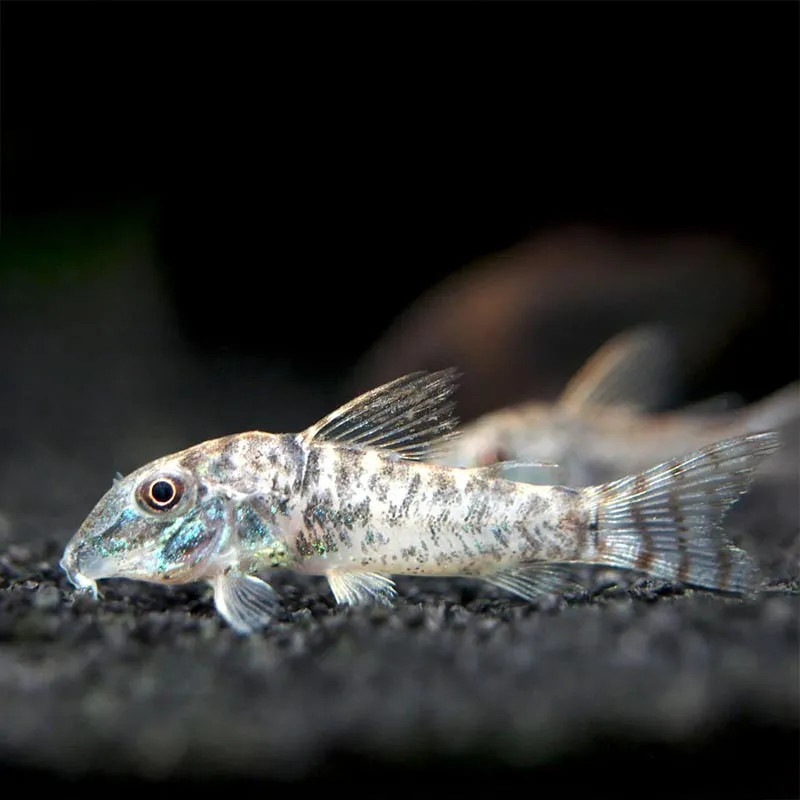Stocks Available
Albino Cory Cat
SKU:114124
CORYDORAS AENEUS
1.25 INCH

Stock Available
Introduction: • Species: Corydoras septentrionalis • Common Names: Northern Longnose Cory, Northern Corydoras • Natural Habitat: Inhabits the slow-moving waters of rivers and streams in the Amazon Basin, particularly in areas with soft substrate and plenty of aquatic vegetation. Physical Characteristics: • Appearance: Characterized by a slender, elongated body with a pointed snout and distinctive dark markings. Its body color ranges from light tan to gray, often featuring dark spots or bands. • Size: Typically reaches a length of about 2 to 3 inches (5 to 7.5 cm). • Lifespan: Can live for 5 to 10 years under proper care. Habitat Requirements: • Tank Size: A minimum of 15 gallons is recommended for a small group, as they thrive in shoals. • Water Conditions: o Temperature: Prefers a range of 72-78°F (22-26°C). o pH: Ideal pH levels are between 6.0 and 7.5. • Aquascaping: Requires a soft substrate, such as sand or fine gravel, along with ample hiding spots created by plants, rocks, and driftwood. Diet: • Primary Diet: Omnivorous; feeds on a variety of small invertebrates, plant matter, and organic debris in their natural habitat. • Supplemental Feeding: Provide high-quality sinking pellets and flakes, along with occasional frozen or live foods like daphnia and bloodworms. • Feeding Frequency: Feed small portions 1-2 times a day, ensuring a varied diet for optimal health. Compatibility: • Temperament: Generally peaceful and sociable, preferring to be kept in groups of at least 5-6 individuals. • Suitable Tank Mates: Compatible with small, non-aggressive fish species such as tetras, rasboras, and other peaceful community fish. • Incompatibilities: Avoid larger or territorial fish that may pose a threat to their well-being. Care Level: • Difficulty: Considered easy to care for, making them suitable for both beginners and experienced aquarists. • Health Monitoring: Regular water quality checks are essential; monitor for signs of stress or disease, especially in a newly established tank. Breeding: • Breeding in Captivity: Breeding can be successful with the right conditions, including cooler water temperatures and high-quality food. • Spawning: These fish are egg layers, often laying adhesive eggs on flat surfaces. Parents may exhibit protective behavior towards their eggs. Economic Considerations: • Market Demand: Popular among freshwater aquarium enthusiasts for their charming appearance and engaging behavior. • Wholesale Pricing: Generally low-cost, making them accessible to a wide range of hobbyists. • Retail Pricing: Typically sold at affordable prices, reflecting their availability in the market. Sustainability and Conservation: • Wild Population: Generally stable, but habitat loss due to pollution and deforestation may pose future risks. • Aquaculture Efforts: Increasingly bred in captivity, helping to reduce pressure on wild populations. Conclusion: The Northern Longnose Cory is a delightful addition to any community aquarium, appreciated for its lively behavior and sociability. With proper care and a well-maintained environment, these corydoras can thrive, providing joy and activity to aquarists of all experience levels.
Data sheet
16 other products in the same category:
Customers who bought this product also bought: